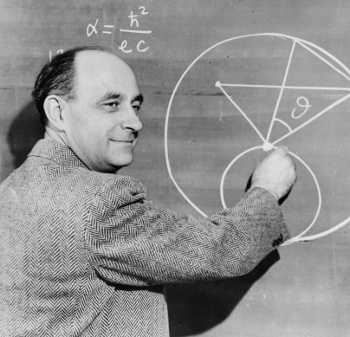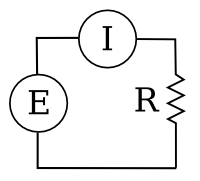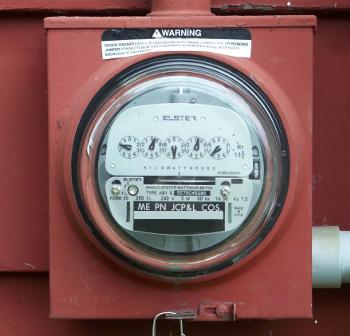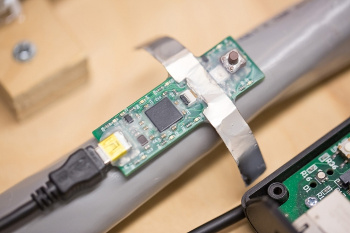Metering Electrical Power
September 1, 2016
One of the
invaluable lessons that I learned while a
student was the
dictum, "You can't improve something if you can't measure it." While this idea is most often applied to
management, it's easy to see how it applies to
science and
technology, also.
A
corollary concept is that you need to know how closely you must make a
measurement for it to be valid. If you're measuring the
oxidation rate of an
alloy by examining the
weight change of a specimen (as my
thesis advisor did for his
thesis, more than half a
century ago), a lot depends on the
accuracy and resolution of your
balance.
Nobel Physics Laureate,
Enrico Fermi, had an interesting observation on measurement,
"There are two possible outcomes: if the result confirms the hypothesis, then you've made a measurement. If the result is contrary to the hypothesis, then you've made a discovery."

Enrico Fermi at a blackboard.
Fermi's smile might indicate that he was joking when he wrote the wrong expression for the fine structure constant, alpha, a fact easily discovered through dimensional analysis.
(Image from the Smithsonian Institution, via Wikimedia Commons)
One measurement that impacts all
homeowners is their
electrical power usage. In
Tikalon's Northern New Jersey region, the
cost of
electricity is about $0.095/
kilowatt-hour, heaped atop a "delivery charge" of about $0.02/kilowatt-hour. This is slightly below the national average of about $0.105/kilowatt-hour. Electrical power of a simple
series circuit, as shown in the figure, is easily
calculated in combinations of the
load resistance R, the
current I, and the
voltage E, as shown.

(Created using Inkscape.)
Since the load resistance of your home is variable and essentially unknown, the power can be calculated only as the
product of current and voltage. Today's
electronic and
computer technology allows
high precision measurement of current and voltage, their
multiplication, and
integration, so it's possible to measure power usage this way. However,
residential power meters have existed for at least a century; so, how do power meters measure the electrical power consumed?
Power meters use
electromechanics in the form of a
motor whose speed is
proportional to the product of voltage and current. The motor is a
conducting disc, typically
aluminum, that's driven as a
two-phase induction motor by a voltage
coil and a current coil. The driving
force is an
eddy current in the disc, and the spinning disc drives a
mechanical counter. Since the current and voltage are
alternating, the supplied and measured power are affected by the
phase difference between the (roughly)
sinusoidal voltage and the current
waveforms. Only the
in-phase components of voltage and current produce power.

The electrical power meter on the outside of my house. The motor disc is visible through the central slot.
Newer meters have an error of just a fraction of a percent,[1] which is remarkable, considering their operating environment.
(Photo by the author)
While residential electric meters accurately measure the total power used in a
house,
energy-conscious people would be interested in how much power is used individually by their home electrical items. Such items include
light bulbs,
refrigerators,
televisions,
computers,
dishwashers,
home heating systems,
air conditioners, and
water pumps. Newer models of many items are more
energy-efficient, a prime example being
LED light bulbs. A little
analysis of power consumption data would indicate which
energy-hogs should be replaced, but only if there were an easy way to monitor the power used by individual items.
That's the problem recently addressed by
electrical engineers at the
Massachusetts Institute of Technology (MIT, Cambridge, Massachusetts).[2-3] They've developed a non-contact
sensor that monitors the power demand of devices through
electromagnetic emissions from their
electrical cables. Everyone who's tried to receive
AM radio inside a house knows that such emissions exist. The advance made by the MIT engineers is to associate these emissions with particular devices and
wirelessly transmit the power usage data.

The MIT electric power monitor at the surface of a multi-conductor cable.
(MIT photo by Bryce Vickmark.)
Steven Leeb, a
professor in MIT's
Department of Electrical Engineering and Computer Science and two of his
students, David Lawrence and John Donnal, have
published the results of their
research in a recent issue of the
IEEE Sensors Journal.[2] Another paper on the topic including
co-author James Paris is still in press.[3]
Their approach to power measurement has several advantages, the first being that no signal wiring is required. The
postage stamp sized sensor is simply placed on the power line. Precise
orientation is not important, since the sensor is
self-calibrating. The device takes frequent data samples very quickly, which allows detailed identification of spikes and
patterns in the voltage and current. The system
software uses this information to identify the types of electrical devices connected to the power line when used with a calibration
reference load.[3]
The research team was able to eliminate errors arising from mis-orientation of the sensor by having an
array of five sensors in the power monitor. Each of these is offset slightly from the others, and the software determines which sensor produces the best signal.[3] Testing at
Fort Devens Army base, and aboard the
U.S. Coast Guard cutter,
Spencer, helped to build a catalog of
waveform signatures for different electrical devices.[3] A
user interface was developed to present the power data in a human-readable format.[3]
One criticism of
home automation products is that their
cloud-based data interface might allow
criminals to access power usage information to determine whether or not a home is occupied. The raw data from the MIT system is under a homeowner's control.[3] During testing, the MIT power sensor discovered a significant
energy-saving opportunity, and also an
anomalous voltage pattern that revealed a wiring flaw that diverted dangerous voltages to some
copper plumbing.[3].
Says Leeb, "For a long time, the premise has been that if we could get access to better information [about energy use], we would be able to create some significant savings." [3] Leeb estimates that a
commercial version of his power sensor would monitor an entire home for a cost about $20-$30. One help for home use is the ease of installation. Says co-author, John Donnal, "It just goes on with a
zip tie."[3] This research was funded by the
Grainger Foundation and the
U.S. Office of Naval Research, among other agencies.[3]
References:
- American National Standards Institute, Inc., "ANSI C12.20-2010, American National Standard for Electricity Meters - 0.2 and 0.5 Accuracy Classes," August 31, 2010, (1.2 MB PDF file).
- David Lawrence, John S. Donnal, and Steven Leeb, "Current and Voltage Reconstruction From Non-Contact Field Measurements," IEEE Sensors Journal, vol. 16, no. 15 (August 1, 2016), pp. 6095 - 6103, DOI:10.1109/JSEN.2016.2574245.
- David L. Chandler, "What's wasting power at home? Ask your pap! - New system from MIT can identify how much power is being used by each device in a household," MIT Press Release, August 1, 2016.
Permanent Link to this article
Linked Keywords: Invaluable; student; dictum; management; science; technology; corollary; measurement; oxide; oxidation; reaction rate constant; rate; alloy; weight; doctoral advisor; thesis advisor; thesis; century; accuracy and resolution; analytical balance; Nobel Prize in Physics; Nobel Physics Laureate; Enrico Fermi; hypothesis; blackboard; smile; joke; joking; fine structure constant; dimensional analysis; Wikimedia Commons; homeowner; electric power; electrical power; Tikalon; Northern New Jersey; cost; electricity; kilowatt-hour; series circuit; calculation; calculate; load resistance; current; voltage; Inkscape; product; electronic; computer; high precision; multiplication; integral; integration; electricity meter; residential power meter; electromechanics; electric motor; proportionality; proportional; electrical conductor; conducting; disc; aluminum; two-phase electric power; induction motor; solenoid; coil; force; eddy current; mechanical counter; alternating current; power factor; phase difference; sine wave; sinusoidal; waveform; in-phase; house; error; environment; energy conservation; energy-conscious; light bulb; refrigerator; television set; computer; dishwasher; central heating; home heating system; air conditioner; water well pump; water pump; energy conversion efficiency; energy-efficient; LED light bulb; analysis; energy-hog; electrical engineering; electrical engineer; Massachusetts Institute of Technology (MIT, Cambridge, Massachusetts); sensor; electromagnetic radiation; electromagnetic emission; electrical wiring; electrical cable; AM broadcasting; AM radio; transmitter; wireless; multi-conductor cable; Bryce Vickmark; Steven Leeb; professor; Department of Electrical Engineering and Computer Science; postgraduate education; scientific literature; publish; research; IEEE Sensors Journal; author; postage stamp; orientation; calibration; self-calibrating; pattern; software; reference; array; Fort Devens Army base; U.S. Coast Guard; cutter; Spencer; waveform; spectrogram; signature; graphical user interface; home automation; cloud computing; crime; criminal; energy conservation; energy-saving; anomaly; anomalous; copper; plumbing; commerce; commercial; cable tie; zip tie; Grainger Foundation; U.S. Office of Naval Research; American National Standards Institute; ANSI C12.20-2010.